Back to: Red Sea Reef Slope 4 of 5
Butterflyfishes, family Chaetodontidae: Of the twenty two
species of Butterflies found in the Red Sea, these are the most hardy
and readily available from the region.
| Chaetodon auriga Forsskal,
1775, the Threadfin Butterflyfish; so named for a trailing
filament that grows from the posterior dorsal fin. Some writers
recognize a subspecies, Chaetodon auriga auriga confined to
the Red Sea; this form lacks the "regular" auriga's
dark spot on the soft dorsal fin. Feeds on a wide range of sessile
invertebrates, including coral polyps. |
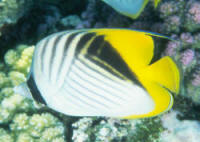
|
|
Chaetodon fasciatus
Forsskal, 1775, the Red Sea Raccoon Butterflyfish, an almost dead
ringer for the wider spread Hawaii to Indo-Pacific Chaetodon
lunula (Lacepede 1803), the Raccoon Butterflyfish to folks in
the west. The Red Sea form is much brighter yellow, lacks the
tail band of the wider-ranging species and has much smaller white
and black head bands.
|
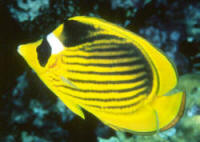
|
|
Chaetodon paucifasciatus
Ahl 1923, the Red-Back or Crown Butterflyfish. Only from the Red
Sea and one of my favorites. An opportunistic omnivore, feeding
on benthic marine invertebrates of all kinds, including coral
polyps. To five inches in length.
|
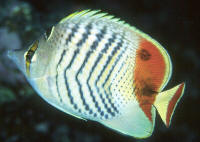
|
| Chaetodon semilarvatus
Cuvier, 1831, the Golden, or Blue Mask Butterflyfish. A fabulous
fish for beauty, swimming grace and hardiness. A large species (to
plate size) that accepts all types of foods in captivity, feeding
mainly on polyps of hard and soft corals in the wild. A Red Sea,
Gulf of Aden endemic species. |
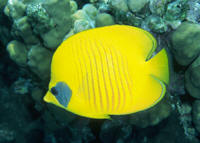
|
| Heniochus diphreutes Jordan
1903, Schooling Bannerfish.(1) Similar to the "common
heni", H. acuminatus, but with smaller mouth and more
rounded breast area. Zooplanktivore that excels in a large,
un-crowded system. Cleaners as juveniles. This one in Gili Air,
Lombok, Indonesia. |
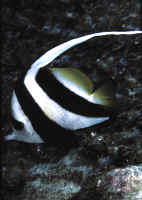
|
| Heniochus intermedius
Steindachner 1893, the Red Sea Bannerfish.(1) Eager feeder on all
types of meaty foods; feeds on zooplankton and benthic
invertebrates in the wild. Only found in the Red Sea and Gulf of
Aden to the south. To seven inches overall length. |
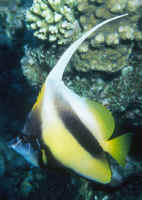
|
Angelfishes, family Pomacanthidae: The larger species of
Angels here are exemplary, even the Regal which is too touchy for
aquarium use from everywhere else. Do look for captive-produced
Asfur's if you have a large fish/tank need for a real showpiece
specimen (hundreds of gallons).
|
Pomacanthus (Arusetta) asfur (Forsskal
1775), the Arabian or Crescent Angel. A fabulous beauty and
centerpiece for very large systems. To sixteen inches in the
wild. Red Sea on down to Arabian Sea and around Horn of Africa to
Zanzibar. Juvenile and adult in captivity.
|
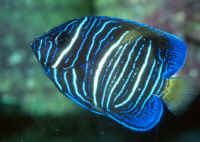 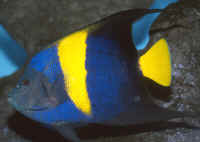
|
|
Pomacanthus
(Arusetta) maculosus (Forsskal 1775), the Yellow-Band
Angelfish. Very similar as adults and juveniles to Pomacanthus
asfur, with told apart from their clear tails and smaller
yellow body patch. To eighteen inches long. Red Sea, Persian Gulf
to east African coast. Adults in captivity and the wild
pictured.
|
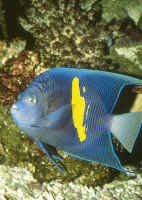 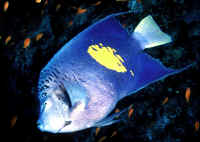
|
| Pomacanthus
imperator (Bloch 1787), the Emperor Angel. Widespread in
the central and western Pacific into the Indian Oceans coasts and
Red Sea. To fifteen inches total length. Shown are a juvenile of
about four inches in captivity and an adult in the Red
Sea. |
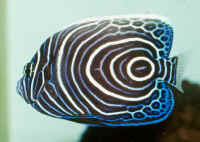 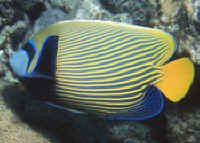
|
| Pygoplites diacanthus (Boddaert 1772), the
Regal Angelfish. Indo-Pacific; Red Sea, East Africa to the
Tuamotus, north to southern Japan. To ten inches in length. Note
the gray chest area of this Fijian specimen. The much more
desirable, hardier Indian Ocean and Red Sea ones have an orange
chest area. Shown: both. |
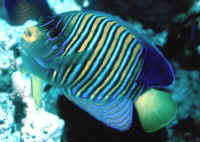 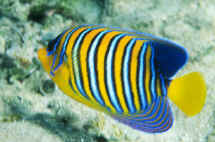
|
Hawkfishes, family Cirrhitidae: The only semi-common species
in the Red Sea (out of five that are found here) is Forster's,
though the Spotted and Longnose are very desirable when/where
encountered.
| Cirrhitichthys oxycephalus
(Bleeker 1855), the Coral Hawkfish. Most widespread species in the
family; from all tropical parts of the Indo-Pacific, Red Sea to
eastern Pacific. To four inches in length. One out in the open (for
a short time) in the Red Sea. |
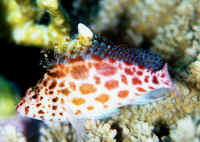
|
| The Long-Nose
Hawkfish, Oxycirrhites typus (Bleeker 1857), The Hawkfish
most hobbyists have seen and want. Found in the Indo-Pacific,
including Hawai'i, This superlatively suitable aquarium species
reaches approximately five inches in total length. The
Longnose is always associated with Sea Fans and Black Coral
"bushes" Red Sea
image. |
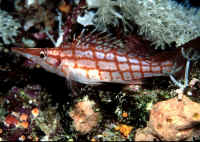
|
| Forster's or Freckled
Hawkfish, Paracirrhites forsteri (Schneider 1801). With a
body marked by dark spots on the front half and horizontal bands on
the rear. This species can be testy and eat goldfish near their
full length of almost nine inches, so be careful when purchasing a
larger one. Indo-Pacific. Juvenile and adult in the Red
Sea. |
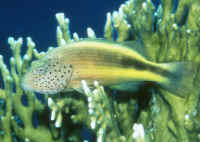 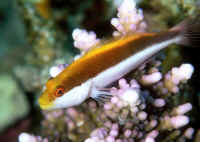 |
Damselfishes, family Pomacentridae: Of the forty species of
pomacentrid species found in the Red Sea, some are much more likely to
be found at or near the reef flat, just on the border with the slope,
and down further amongst sand, rocky rubble and patch reefs. The
following three species are more slope-associated.
| Chromis dimidiata (Klunzinger 1871), the
Two-tone Chromis. Indian Ocean and Red Sea (origin of this image).
To two inches overall length. A more common offering in European
pet-fish markets. Red Sea image. |
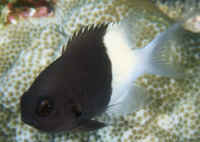
|
|
Amblyglyphidodon flavilatus Allen &
Randall, 1980, the Yellowfin Damsel. Western Indian Ocean, the
Red Sea and Gulf of Aden. To four inches in length. A juvenile
and adult off of Sharm in the upper Red Sea. A.
leucogaster also occurs in the Red Sea.
|
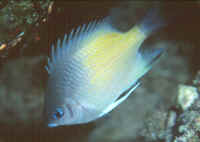 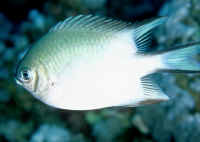
|
Wrasses, family Labridae: Only a couple of labrids are
prominent on the rocky reef slopes in the Red Sea, though most all of
the sixty nine species found here can be found in this habitat on
occasion.
|
Thalassoma lunare (Linnaeus 1758), the Moon
Wrasse (2), sometimes comes in great, other times... all die. Red
Sea and Indian Ocean, to the Line Islands. Length to ten
inches. Can be more green or blue in overall coloration. Young
have a dark spot on their caudal and mid-dorsal fins. A male off
of Gili Air, Lombok, Indonesia, and female in the Red
Sea.
|
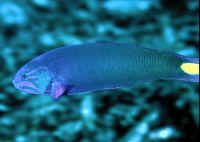 
|
Surgeonfishes, family Acanthuridae: Of the 15 species in the
Red Sea, only four or five can be considered common and coincidentally
of good use to aquarists.
|
Acanthurus nigrofuscus (Forsskal 1775), the
blackish Brown or Spot-Cheeked Surgeonfish. Manageable size (to
eight inches), and moderate behavior toward other fishes qualify
the Brown Tang as a desirable aquarium species especially as an
algae controller. Unfortunately it is a rather plain fish. Red
Sea images of individual and group feeding together to overwhelm
more aggressive, territorial fishes.
|
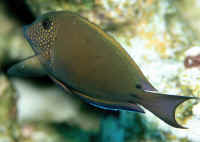 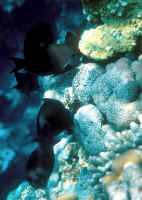
|
| Ctenochaetus striatus (Quoy
& Gaimard 1828) the Striped Bristletooth, is the one member of
the genus found extending into the Red Sea (but also found in the
Indo-Pacific to Oceania and the I.O.); it is the most frequently
imported species in Europe. It's body color is overall drab
olive sporting wavy blue lines. Small orange dots are sprinkled on
the head. One and a couple tussling in the Red Sea. |
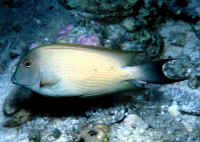 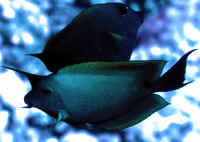
|
|
Zebrasoma desjardinii
("day-har-din-ee-eye") (Bennett 1835), Desjardin's
Sailfin Tang. Seeing this fish and Z. veliferum at the
same time might cause you to do a double take; they are very
similar in color and markings. Desjardin's Tang comes to the
trade mainly from the Indian Ocean or Red Sea, so one way to
distinguish it is by source locale (or cost). It also has a few
less soft dorsal and anal fin rays (28,29D and 22-24A versus
29-33D and 23-26A for the Pacific Sailfin) if you can get yours
to hold still. Actually, the easiest discernible difference is
the markings on the tail. The Pacific is white, yellow and gray
banded, and Desjardin's is dark with whitish yellow spots.
Juvenile below. Currently considered the same species as Z.
veliferum by some authorities. Below: four and six inch
individuals in captivity and a fourteen inch one in the
Maldives.
|
Triggerfishes, family Balistidae. Not always seen, rarely
abundant, but almost always right around the corner, some species of
Triggers from the Red Sea have been utilized in reef systems w/o
"sampling" other tank inhabitants. Only those with large
systems and plenty of nerves need apply. We'll skip the big
bruisers here.
| Balistapus undulatus (Park 1797), the
Undulated or Orange-Lined Triggerfish is both loved and
vilified in our hobby. On the one hand it's a gorgeous species
that is very hardy. On the other it can be a pure terror towards
its tank-mates, eating or "sampling" them all to death.
Don't despair if you have a penchant for keeping this fish.
True, most Indo-Pacific ones are mean to a fault and must be kept
only with like-mad-minded fishes, but do look for the more mellow
Red Sea specimens if you can. These are much more peaceful toward
other species. An Undulated Trigger in the Red Sea shown. |
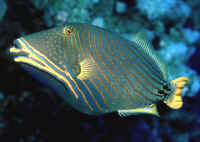
|
|
From further out in the western Indian Ocean and the Red Sea
comes another "Picasso", or (preferably) the Assasi
Trigger, Rhinecanthus assasi (Forsskal 1775). This
one in the Red Sea. To one foot in length.
|
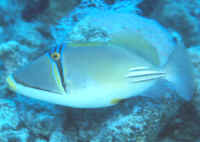
|
Back to: Red Sea Reef Slope 4 of 5
Or on down the slope to: Red Sea Sandy Reef
Slopes, pt. 3
|
|

